osiris-rex
Latest
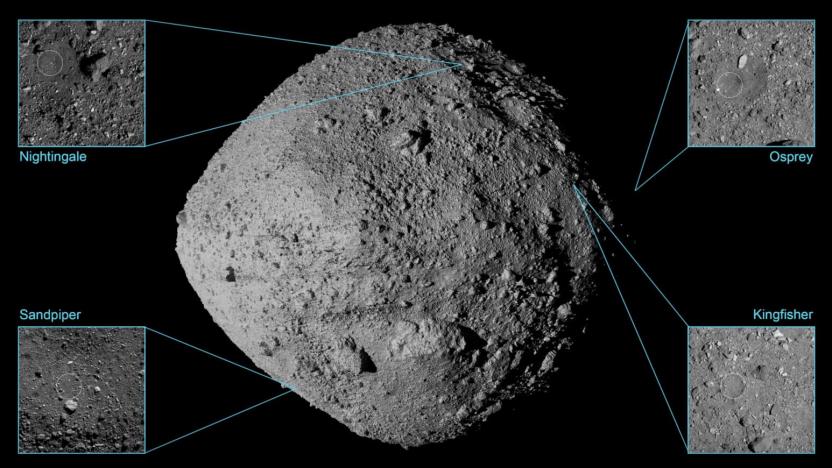
NASA chooses four potential asteroid sample sites for OSIRIS-REx
NASA's OSIRIS-REx team has selected four potential sites for the agency's first asteroid sample return mission. The spacecraft started mapping asteroid Bennu's surface as soon as it arrived in late 2018, and scientists part of its ground team thought they'd be choosing the final two candidate sites at this point in time. Observations made from our planet showed that the asteroid had large areas with fine-grain materials, but images the spacecraft took showed the truth: Bennu has an especially rocky terrain, making it a challenge to collect materials less than 1 inch in diameter. That's the maximum size the probe's sample mechanism can handle.

NASA reveals Bennu asteroid is spewing particles into space
An asteroid slightly wider than the Empire State Building has confused scientists by shooting out plumes of dust, as a new set of close-up images from NASA shows. Bennu, the near-Earth asteroid that NASA's OSIRIS-REx mission has been observing since December 31st, is already confounding scientists in a variety of ways.

NASA's OSIRIS-REx has started orbiting asteroid Bennu
After NASA's OSIRIS-REx arrived at asteroid Bennu in early December, its ground team quickly started measuring and mapping out the celestial body. They needed all the information they could get in order to enter Bennu's orbit, since the asteroid has such a small gravity pull. Sounds like the scientists were able to get what they needed, because OSIRIS-REx has successfully started circling the asteroid at 2:43 PM ET on December 31st.

OSIRIS-REx spacecraft already found water on its target asteroid
It didn't take long for NASA's OSIRIS-REx spacecraft to glean valuable insights from the asteroid Bennu. The vessel has helped scientists discover water trapped inside Bennu's clays thanks to its two spectrometers, which spotted the hydroxyls (bonded hydrogen and oxygen atoms) that indicate interaction with water. Researchers believe Bennu's parent astroid hosted liquid water at one point, and these traces carried over to the smaller space rock.
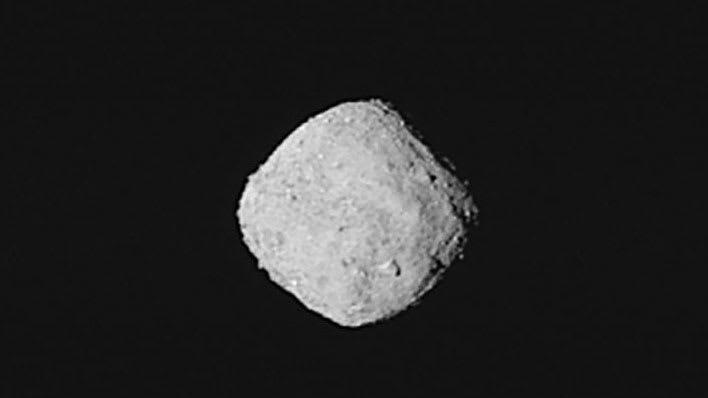
NASA’s OSIRIS-REx spacecraft has arrived at the asteroid Bennu
NASA's OSIRIS-REx spacecraft has officially arrived at the asteroid Bennu after a more than two-year-long journey. The spacecraft rendezvoused with its target around noon EST, and NASA confirmed the arrival a few minutes thereafter during a live event today.

After Math: To all the turkeys I loved before
The holiday season has officially kicked into high gear, which means it's time to gather around the hearth, count your blessings and quietly roll your eyes as uncle Jerry launches once again into why smoke wouldn't rise straight up if the Earth weren't flat. While he's blowing smoke about thermodynamic theory, here are some examples of tech institutions finding the holiday spirit and giving back to their fans.
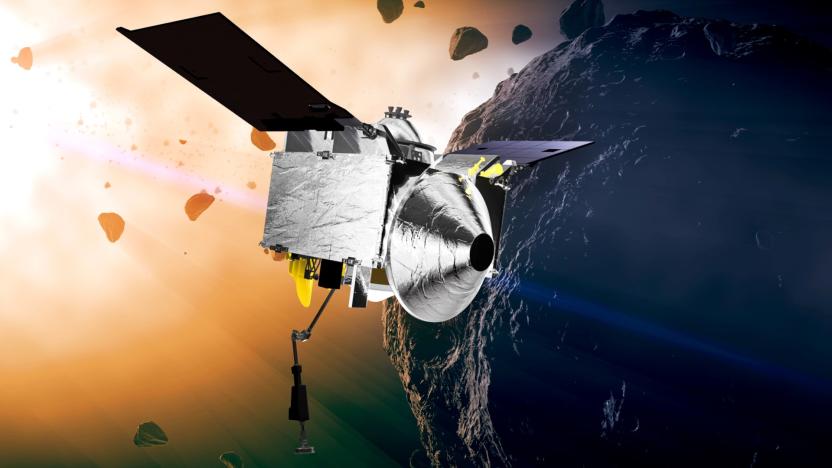
NASA successfully tests OSIRIS-REx robotic arm ahead of arrival
NASA's spacecraft OSIRIS-REx is just 75 miles from its destination and, just like you would near the end of a light, it's starting to stretch out. The craft successfully tested its Touch-and-Go Sample Acquisition Mechanism (TAGSAM), a robotic arm that will allow it to grab samples from the surface of the asteroid Bennu.

A portrait of Earth and the Moon from 3 million miles away
Sometimes you need to step back to see the big picture, and if your subjects are 249,000 miles apart, you need to step waaay back. Luckily, the spacecraft OSIRIS-REx is moving rapidly away from us and was recently just in the right position, around 3.1 million miles away, so it trained its MapCam instrument towards its former home and captured this poignant portrait of the Earth and the Moon.

'Asteroid Day' is a good time to learn about the threat of space rocks
On June 30th, 1908, more than 770 square miles of remote Russian forest were obliterated from the face of the Earth when a relatively small meteor, estimated at only around 400 feet across, unleashed 15 megatons of energy above the Stony Tunguska River. One hundred and nine years later, humanity knows precious little more about the dangers that lurk within our solar system than we did in 1908. But a recently founded "global day of education" aims to bring the existential threat that space rocks pose to the forefront of our collective consciousness.
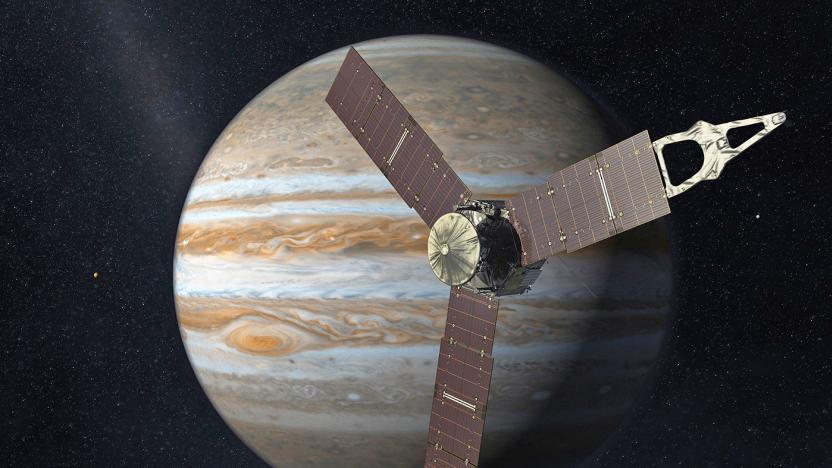
NASA is reviewing candidates for its next Solar System mission
NASA might be focusing on Mars recently, but it hasn't forgotten the rest of the Solar System. The agency has begun reviewing the 12 proposals it received for the New Frontiers program, the same one that gave rise to New Horizons, Juno and other notable unmanned missions. All the proposals will go through scientific and technical probing with the next seven months, with one or a few moving on to the next phase of the selection process. NASA will choose the best mission to develop in 2019 and will spend up to $1 billion to make it a reality.
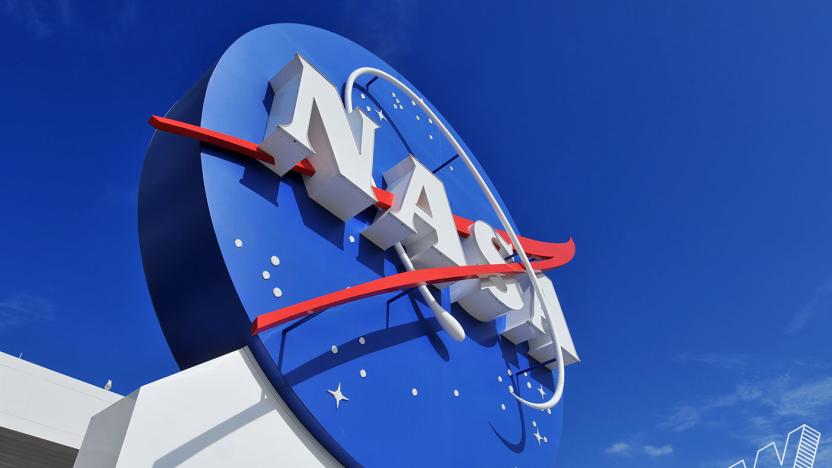
NASA dominated space and social media in 2016
"We all have a thirst for wonder," American astronomer Carl Sagan wrote in his sci-fi novel Contact. "It's a deeply human quality." And it's partly thanks to this "thirst" that NASA had the space game on lock this year, even though it doesn't have access to as much money as it used to. The agency stepped into 2016 armed with $19.3 billion in government funding. Yes, that's almost a $1 billion more than what the administration originally asked for, but it's also significantly lower than NASA's budget in previous years, when adjusted for inflation.

NASA's asteroid-bound OSIRIS-Rex launches Thursday
After years of construction and months of rigorous testing, NASA's asteroid-sampling OSIRIS-Rex spacecraft is ready to take off from Cape Canaveral this Thursday, September 8th at 7pm ET. After it leaves the atmosphere on an Atlas V rocket, the spacecraft will take two years to reach its destination, a near-Earth asteroid called Bennu. Upon arrival in 2018, OSIRIS will begin an multi-year mission of mapping the 1,650-foot asteroid and bringing home a scoop of carbon-rich space rocks, which researchers believe may hold 4.5 billion-year-old leftovers from the beginning of the solar system and some of the basic building blocks of life. Update (9/8): You can watch NASA's livestream of the launch (scheduled for 7:05PM ET) right here or embedded below.

NASA's asteroid-bound spacecraft will blast off in September
It's official: OSIRIS-Rex is blasting off to meet a near-Earth asteroid named Bennu on September 8th, NASA has confirmed at a press briefing. The spacecraft will launch from Cape Canaveral and travel for two years before it reaches its destination. Once it's on the object, it will spend another three years to take its temperature, 3D scan its surface, and look around for the best site to collect the 2-to-70-ounce sample it needs to take back home. That's right -- OSIRIS-Rex will be the first US spacecraft to grab a chunk from an asteroid as part of its round-trip journey. It follows in the footsteps of Japan's Hayabusa, which successfully brought home a sample after seven years in space. NASA expects the spacecraft to be back by September 24th, 2023, assuming everything goes according to plan.
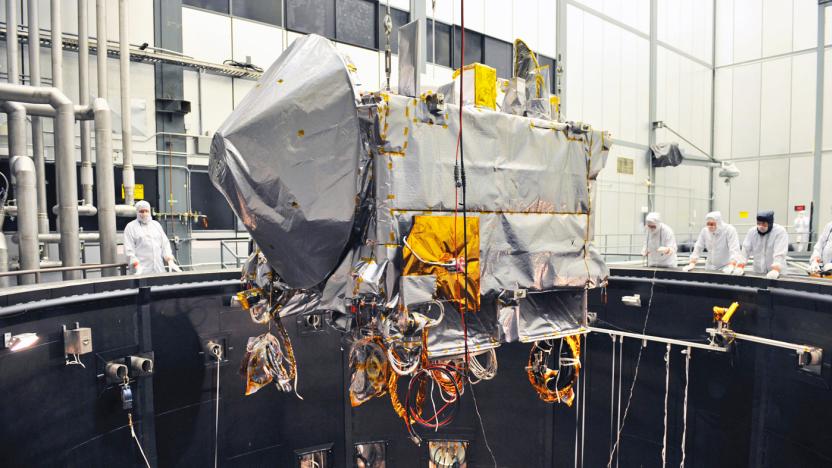
NASA's asteroid explorer faces tests that simulate space
Before NASA's OSIRIS-REx spacecraft can visit an asteroid to collect samples, it'll have to run a tough gauntlet. The probe is undergoing a 22-day thermal vacuum test that will see whether or not it can function in the unforgiving conditions of space. On top of working in an atmosphere-free environment, it'll face temperatures as cold as -274F and the periodic heat of a simulated Sun. So long as OSIRIS-REx makes the grade, it'll largely be ready for its September launch and the epic 7-year journey toward the asteroid Bennu.

OSIRIS-REx is complete and will collect asteroid samples in 2016
It seems like only yesterday that OSIRIS-REx got its first scientific instrument: a thermal emission spectrometer that can take the temp of an asteroid called Bennu every two seconds. Now, Lockheed Martin is done building the spacecraft, and NASA's slated to send it off to space in 2016 to collect samples from the near-Earth asteroid. Before it blasts off, though, the probe will undergo more rigorous testing as a whole spacecraft within the next five months. That includes subjecting it to extreme temps, vibrations, electromagnetic interference and vacuum that simulate space travel.

Asteroid-bound spacecraft gets its first scientific instrument
NASA has begun attaching scientific instruments to the OSIRIS-REx probe, just over a year before it starts making its way to asteroid Bennu. The first instrument to arrive at Lockheed Martin's HQ is Arizona State University's microwave-sized device called OSIRIS-REx Thermal Emission Spectrometer or OTES. It's designed switch on shortly after the spacecraft begins its two-year journey to Bennu, and to take the near-Earth asteroid's temperature every two seconds once it arrives. The instrument, which has undergone development and testing these past few years, will also scan the celestial body's surface to map minerals and chemicals.

NASA wants to put your name on a spacecraft headed to an asteroid
Forget those dime-a-dozen "name a star" gifts -- wouldn't you rather put your name on a spacecraft that advances human understanding? NASA certainly thinks you do. It's teaming up with the Planetary Society to etch your name on chips inside its OSIRIS-REx probe, which will head toward the asteroid Bennu in 2016. While it's doubtful that any aliens will read your microscopic claim to fame, it'll certainly get the grand tour. The spacecraft will spend 500 days around the asteroid before heading back, and both the decommissioned vehicle as well as the returning sample capsule will have your ID. You can register your name today for free; just be prepared to wait years for the payoff.

NASA asteroid mission could explain how life began (and how ours might end)
There's a slight chance that the Earth could get hit by an asteroid in about 170 years, but don't you worry -- NASA's all over it. This week, the agency announced a new mouthful of a mission known as Origins-Spectral Interpretation-Resource Identification-Security-Regolith Explorer, or OSIRIS-REx, for short. The $800 million initiative, part of NASA's New Frontiers Program, will send a spacecraft to link up with 1999 RQ36 -- a nearby asteroid that's likely rich in carbon and other organic molecules that could explain how life forms originated. After about four years of space travel, the craft should get close enough to map the asteroid's surface, before using its robotic arm to extract at least two ounces of material and return it to Earth by 2023. Scientists will also pay close attention to something known as the Yarkovsky effect, which determines how an asteroid's path changes as it absorbs and emits energy from the sun. OSIRIS-REx will attempt to measure this affect for the first time, perhaps allowing NASA to predict the trajectories of potentially hazardous asteroids -- including the RQ36. The 1,900-foot wide rock is expected to approach Earth by the year 2182 and, according to recent estimates, there's a one in a thousand chance that it could actually strike our planet. Now if you excuse us, we have to go prepare a bunker for our great-great-grandchildren. Head past the break for a video and full press release.







